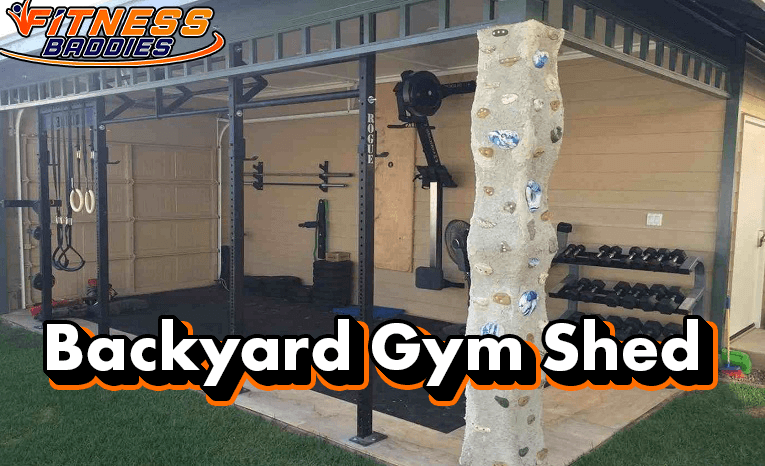Reverse Pyramid Training Full Guide – Here’s What You Need to Know About This Training Style
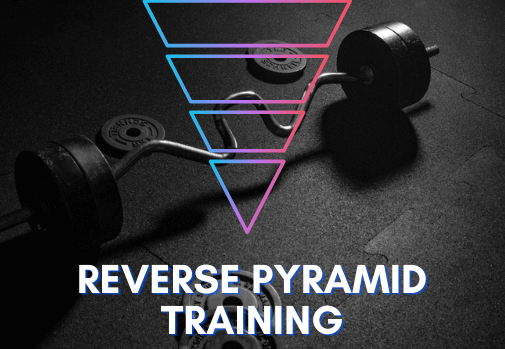
The more people you talk to in a gym, the more theories you’ll hear about what works best… Some claim heavy weights and low reps, while others go the other way around.
Both options do work but in different ways. At the end of the day, it depends on what you're after.
Whenever I hit the gym, I'm always curious to see what kind of workouts other people are doing. No matter how experienced you are, there’s always room for improvement. New ideas, new techniques, new ways to perform certain exercises, and so on.
I recently met someone who's doing things in a different way, and it's been an interesting conversation. That's when I first heard about reverse pyramid training (RPT). Since then, I have been fascinated by this unique approach to fitness and improving overall strength.
To reach my fitness goals, I followed a classic training style. I started at a low weight to warm up and then added pressure on my muscles by gradually increasing the weight until I could barely do five reps. Once I achieved this, I moved on to another exercise.
It works, of course, but there are other ways to look at it too. This guy was going the other way around.
After a brief session of warming up, he picked the heaviest weights, did congdon curls with few reps, and then worked his way down. I thought hmmm, that's interesting.
After all, once I reached my top weight, my muscles were dead, and I could barely use them for something else. But doing it in a reverse order made it look easier. After all, each set is easier and easier, or at least that’s what I thought.
Unsurprisingly, the concept worked well, especially since I was stagnating for quite a while. Besides, it helped me realize that I could do much more than I thought.
If you think about it, if you add weight gradually, you’ll be pretty tired by the time you reach your potential, so you’ll never know your real potential. But if you start with the heaviest weight while on full energy, you’ll see different numbers.
Anyway, reverse pyramid training is a solid thing these days, and while not as popular as other routines, it can and will work wonders. Now, let me get into smaller details…
What's reverse pyramid training?
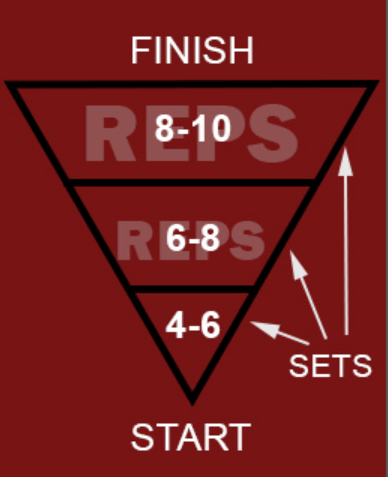
Reverse pyramid training is most commonly recommended to burst through a plateau. You’re doing things in a slightly different manner. You’re challenging your muscles by pushing more than normally, only because you start with the heaviest possible weight.
It makes no difference what exercise you try. You could do seated tricep press or perhaps zottman curl. This training style implies starting with the heaviest weight and performing with a limited number of repetitions. Don’t go as high as barely doing one or two reps. Instead, opt for at least five reps.
Once you complete a set, you can reduce the weight for the next one, but you’ll have to do a few more reps as well. It’s a balance. It does feel lighter because of the weight, but the extra reps will help you keep your workout in an effective balance.
Most people using the reverse pyramid training style will go for about 10% less weight with each new set. Based on the available weights, you may not always manage to get precisely 10% off, but anything between 8% and 10% will do.
If you’re dedicated to fitness, you probably keep a journal too. Keep an eye on the weights and write everything down, too, just so you can track your progress.
Reverse pyramid training example routine
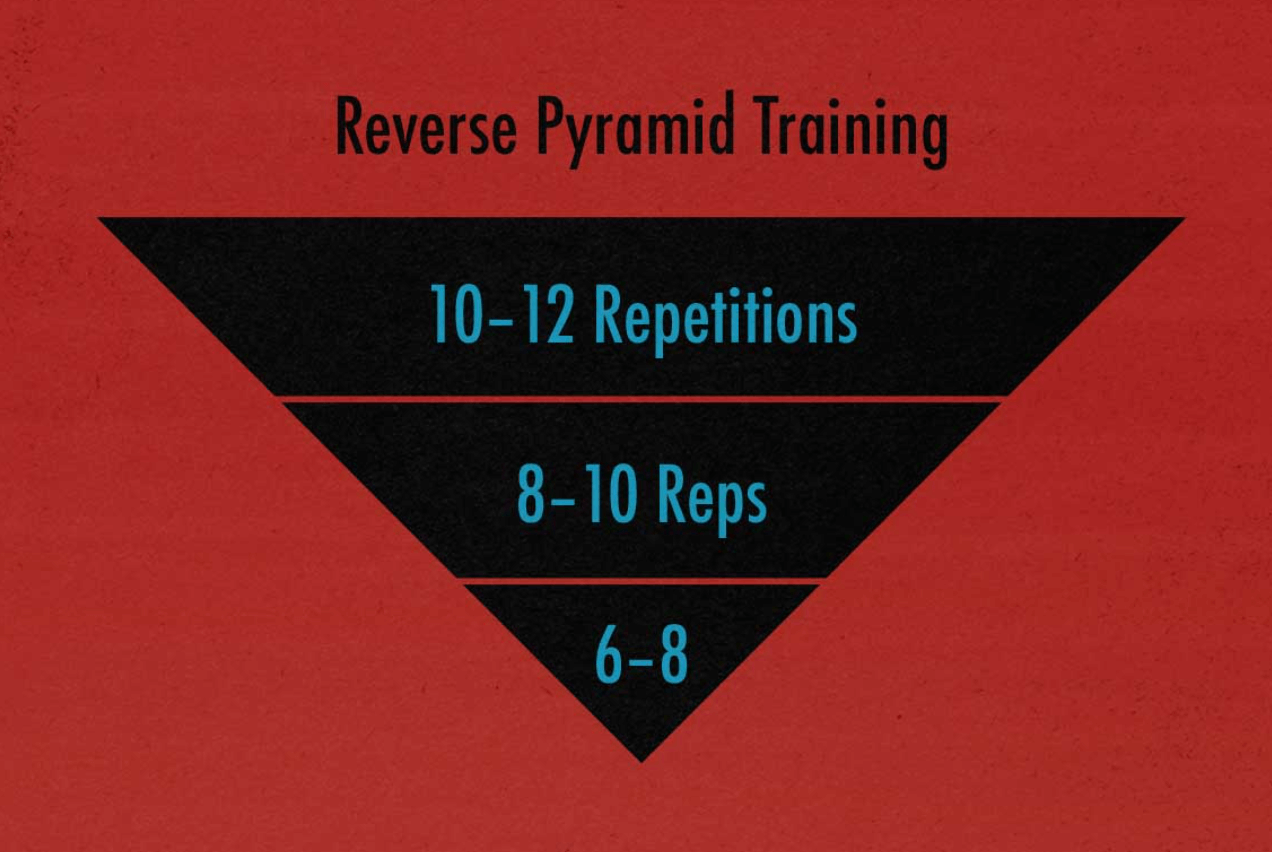
Reverse pyramid training is based on a pattern. Just like everyone else, I've got my own pattern. You'll have to find out yourself what works since everyone does it differently. The concept is the same, but weights and reps vary.
There are, however, different routines online you can try, especially if you’re not sure where to start. We’ve all started like this, then you can adjust later on.
Let me give you an example similar to what I used when I started.
It's simple, and it covers a full body workout, as well as three days a week only.
Of course, you can try something else, maybe focus on triceps and biceps on the same day or shoulders workout after chest day. But to me, it was a great starting point to get used to reverse pyramid training.
It's based on three sets for each exercise, a couple of exercises per session, and getting to the gym every other day.
Here's what I did:
Day | Exercise | First set | Second set with 10% less weight | Third set with 10% less weight |
Monday | Deadlifts | 5 reps | 8 reps | 10 reps |
Weighted chin-ups | 6 reps | 10 reps | 12 reps | |
Wednesday | Bench presses | 6 reps | 10 reps | 12 reps |
Push-ups | 8 reps | 10 reps | 12 reps | |
Friday | Squats | 6 reps | 10 reps | 12 reps |
Overhead presses | 6 reps | 10 reps | 12 reps |
Now, let me clarify a few things…
You can't add too much weight to push-ups to get bigger chest. I don't recommend having weights on your back unless you're training with someone else to help you. You can get something hanging off your waist for push ups, but that’s pretty much it.
If you can’t do any of these, simply go for 12 reps every single time. Basically, there’s no reverse pyramid training for this exercise, but it’ll still work when mixed with others.
Does reverse pyramid training work?
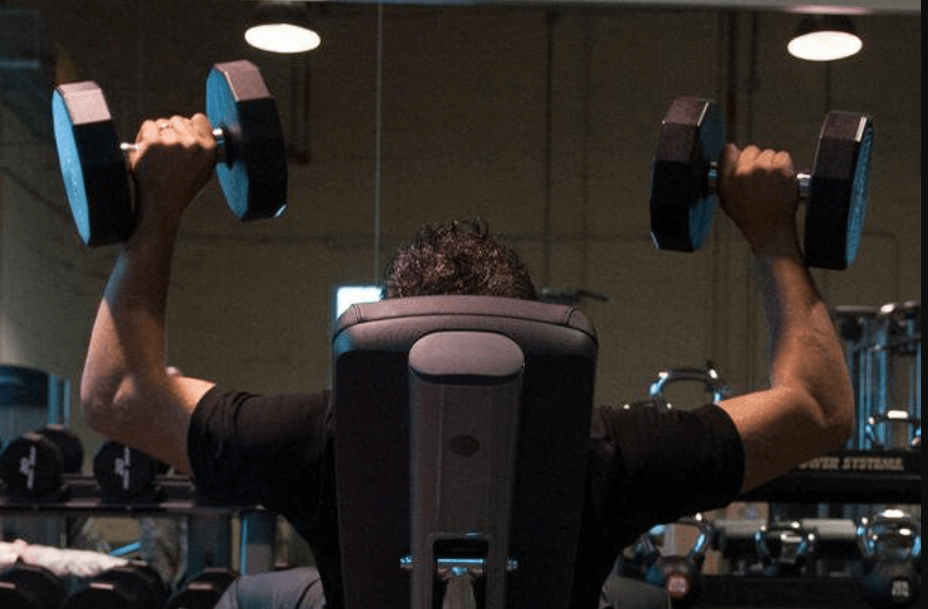
Generally speaking, you want to make sure something works before you try it out, and the same rule applies to reverse pyramid training too.
So said, so done… I’ve done a bit of research about it to see how it works.
Certain things make common sense. For example, if you hit a plateau, give yourself a month of reverse pyramid training, and you'll see some results. Well, I did…
Second, there’s another thing that makes sense to me. When you increase weights for the next set gradually, you’ll be pretty tired by the time you reach the maximum load, so you can’t exercise at your full potential.
In reverse pyramid training, you start with the heaviest load so you unleash your full potential. And that’s pretty convincing for me. Taking breaks in between is essential, and adding Kachva or Huel meal replacement shakes to your post-workout meal can help ensure that you get the necessary nutrients for muscle recovery.
In terms of science, there’s evidence that both classic and reverse pyramid styles have something to offer. Reverse pyramid provides gains with a low total workload, though, only because you lift more.
There’s a greater intensity during super heavy sets than during low weight sets, of course.
At the same time, the harder you push, the more you work on those fast-twitch muscle fibers. These fibers give you more growth than others but also more hypertrophy and strength.
Advantages of reverse pyramid training
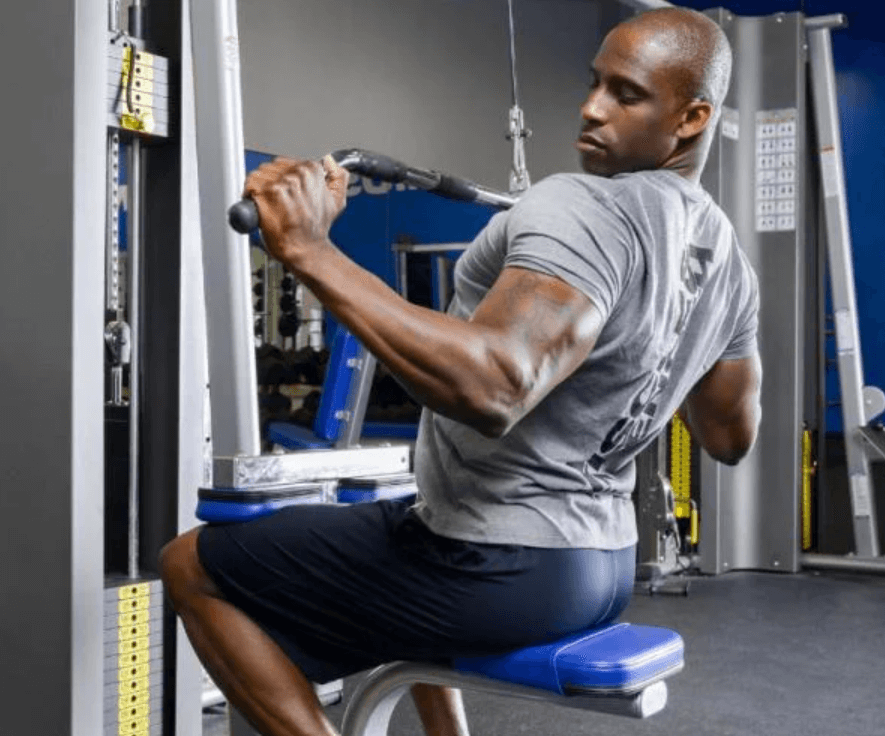
Strength and power surge
Apart from the above mentioned ideas, reverse pyramid training gives you more of everything, both strength and growth.
When you train with a moderate rep range, you’ll see good muscle gains. When you train with heavy weights and barely do a few reps, you’ll notice more strength. Reverse pyramid training gives you more of both muscle gains and strength.
Possibility to see your full potential
Back in the day, I trained the other way around and got smashed by the time weights became heavy. But doing it in reverse order, I can start with a much heavier load because there's no fatigue, well, not yet.
I noticed an increase of up to 25% in my lifting potential when I followed RPT for the sumo deadlift on a smith machine in order to build bigger quads.
Workouts require more time too, so if you normally train for an hour, you can do with 45 minutes in reverse pyramid training only. That’s about 25% more time efficiency.
Psychological benefits
You see your real potential, which is motivational. You can see growth, especially if you’ve hit a plateau. All these things work on the mental part, which is just as important in the process.
Plus, if you’ve always trained the traditional way, this is something new.
I feel happy and motivated whenever I try something new in the gym… How’s it going to affect me? How am I going to feel? Is it helpful? Useful? What about the results? All these things push you from behind a little. It’s basically the effect of variety.
Now, the reverse pyramid is super helpful when using compound exercises. You probably know already they’re great for both gain and strength. However, they're also more accurate when it comes to estimating your real potential, and that helps in seeing how far you've come.
Measuring your real potential is great for tracking workouts.
Drawbacks of reverse pyramid training

Not a perfect workout
Based on the above mentioned advantages, reverse pyramid training is definitely worth a try. It’ll bring in a plethora of benefits, but it’s not perfect. In fact, no training technique is perfect, that’s why we need variety.
Not sustainable
You’ll train close to failure, right? That means you'll need more time to recover. If you plan to train your shoulders four times a week by doing shoulder press or lateral raise, it probably won't work.
Other than that, when training close to failure, you're more likely to get injured. You're more likely to fail in maintaining the right form only because it's too heavy.
What I did was perform a set in the mirror while looking at myself. You can also record workout video. The general idea is you need a perfect form to avoid injuries, and that's not always the case for beginners.
Therefore, I recommend reverse pyramid training only if you’re actually experienced with traditional training styles.
Finally, these workouts won’t be light, I’m warning you.
Mentally and physically draining
You can normally push more than what you think, so that’s a bit challenging. Knowing you’ll need to go close to failure can make you think twice about your workout. It’s draining you both mentally and physically.
And then, you need to do all these while focusing on maintaining the perfect form.
Like I said, this isn’t sustainable and only recommended as extra variety to your workouts. Meanwhile, stick to classic patterns, such as five reps with a heavy load or around 10 reps with less weight.
Why is warming up necessary for reverse pyramid training?
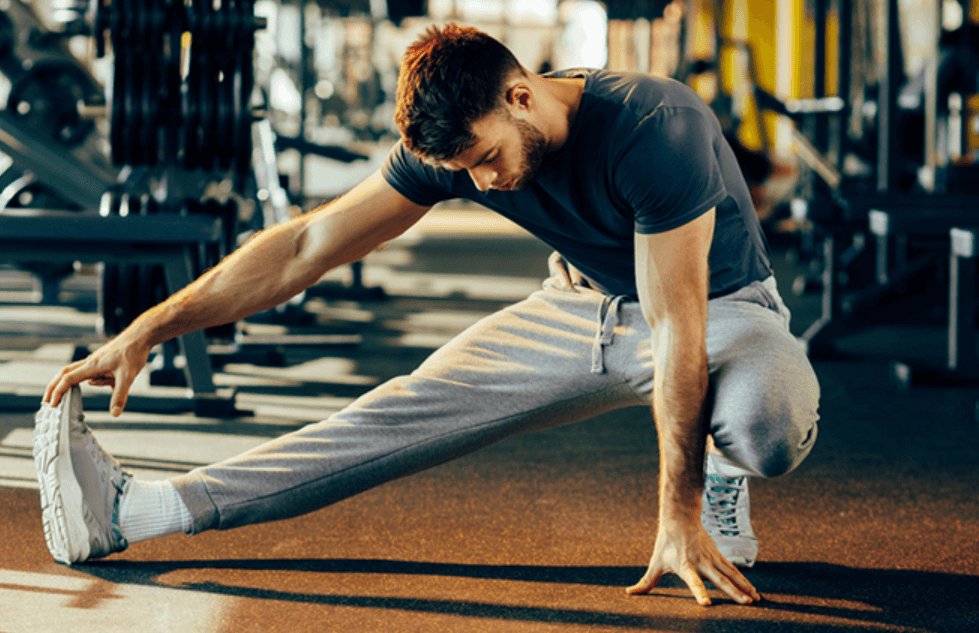
I won’t get into details, but you might have noticed that I recommend caution. Besides, there are also a few tips and tricks to ensure there are no injuries, mostly related to the form. But there’s more…
Just like for any calisthenics or weight lifting workout, you’ll have to warm up. Warming up for reverse pyramid training is a different kettle of fish, let me explain why.
Warming up is a must because you have to be flexible. You want your muscles to be warm and have a good range of motion. Otherwise, you risk facing an injury.
The blood should be thoroughly flowing around the muscles, as well as the oxygen.
Now, here comes a secret…
Have natural pre workout and try to focus your warming up session on the muscles you're planning to work on. You want them to be flexible and warm to prevent injuries. Sure, full body warming up works too, but insist on these muscles.
And now, my second secret… Don’t overdo it!
If you warm up for too long, the respective muscles could be slightly fatigued, which is the last thing you want. You want them warm, not tired. Sure, fatigue will be minimum, but it may still affect your workout.
In other words, warming up for reverse pyramid training is a must. It’s a matter of health and safety, but it also comes with some restrictions.
Warming up is not all about preventing injuries, it will also promote quicker recovery.
Reverse pyramid training vs. traditional pyramid training vs. straight set training
Each type of training style has its own characteristics.
To me, each of them works wonders if you blend them correctly. But to help you make a better decision, let me explain the main differences.
Reverse vs. traditional pyramid training
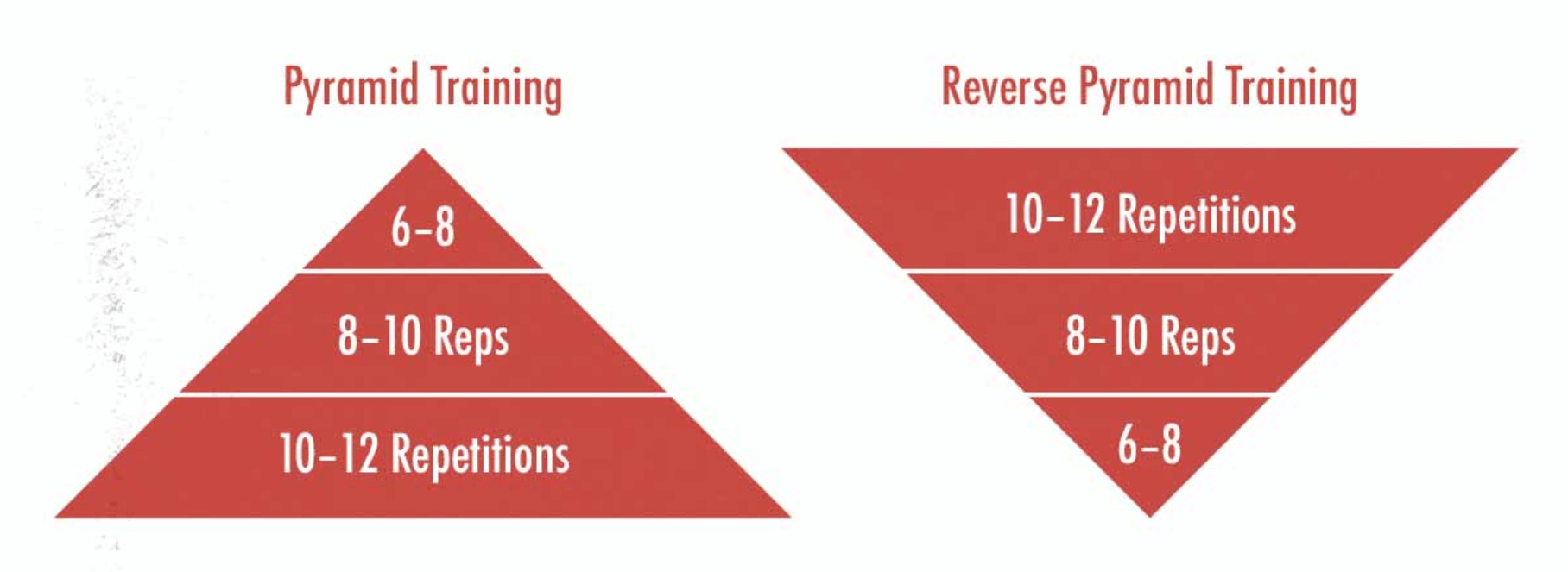
In traditional pyramid training, you’re doing it differently. You start with low weights, something to challenge you a little, but far from your maximum load.
With every new set, you bring in heavier weights. Most people don’t bother about percentages here. I’ve never done too much math, either.
If you use cheap adjustable dumbbells, just get the next weight up. If you use a cheap barbell, add a couple of light plates on each end to retain balance, simple as that.
It's not bad, but there's a problem, and I've explained it before.
By the time you get to heavy sets, your muscles are quite tired. Your final set won’t necessarily be your real potential because you’ve already drained your muscles with previous sets.
In other words, it won’t maximize your gaining capability.
Reverse pyramid training starts with the other end, the heavy one.
Middle sets are common in both styles, but reverse pyramid training brings in lighter weights at one end, while traditional pyramid training brings in heavier weights at the other end.
Reverse pyramid training vs. straight set training
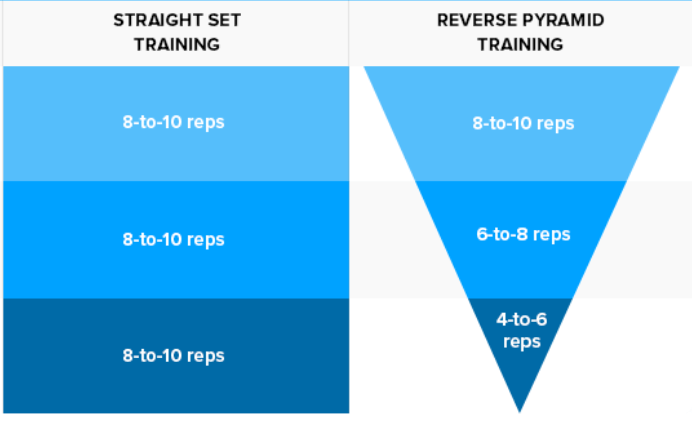
Now, for this one, you'll need to understand what straight set training means. The concept is pretty simple, and we've all done it at some point.
Whether you do three, four, or more sets of one exercise, straight set training implies using the same weight. It makes no difference how many reps you do either. You could do 3x8 or maybe 5x5 or 4x10, it makes no difference.
If you use the same weight, it’s the straight set style.
If you’ve been careful before, you should know already that reverse pyramid training brings in extra gains in strength.
So, is straight set training superior in anything? Yes, it is. It brings in more volume. If you want to see gains and growth, this is the way to go.
Like I said before, it's imperative to add some variety to your workouts…
My best bet is to combine different types of training styles based on what you work on. When it comes to big compound exercises for the largest muscle groups, go for reverse pyramid training. If you’re doing isolated groups like biceps or triceps, opt for straight sets.
Frequently Asked Questions
If you're new to this style of training, there are likely many questions that come up apart from how it works, its benefits, and more. Here are the most frequently asked questions about reverse pyramid training.
How effective is RPT?
From many points of view, reverse pyramid training is an effective style regardless of what you're trying to achieve. Youth weight lifting training, in particular, is among the most effective ways to burn fat and build muscle. Reverse pyramid training allows touching your full potential, unlike other styles.
How often should you do reverse pyramid training?
I don't find reverse pyramid training to be sustainable in the long run. In my opinion, it's not about how often you should do it but about how to blend it in. Use it for compound exercises only and stick to straight sets for everything else, so you can basically adopt this style during each workout.
Is pyramid or reverse pyramid training better?
Both styles cover pretty much the same weights when training, with a few exceptions. Traditional pyramid training covers the lower range of your potential, while reverse pyramid training boosts the higher end and unlocks your full potential, so it’s much more effective.
Is pyramid good for building muscle?
Reverse pyramid training is great at building muscle, but it’s even better at building strength.
Bottom line
While often overlooked, reverse pyramid training is an excellent style that will give you access to your full training potential.
I had my own limits in pretty much any exercise that involved weights. Once I started this training style, I went up in my limits, anywhere between 10% and 25%.
Your full potential is a misleading number in other training styles, while reverse pyramid training will give you a more honest approach.
Related Articles:
- I Did 100 Pushups 100 Situps 100 Squats for 30 Days – Results and What I Learned
- The Booty Belt Workout – Is This Booty Workout System Really Worth it?
- Triceps Not Growing? I’ve Got Your Back
- Hips Don’t Lie: How Many Lunges Should You Do a Day?

